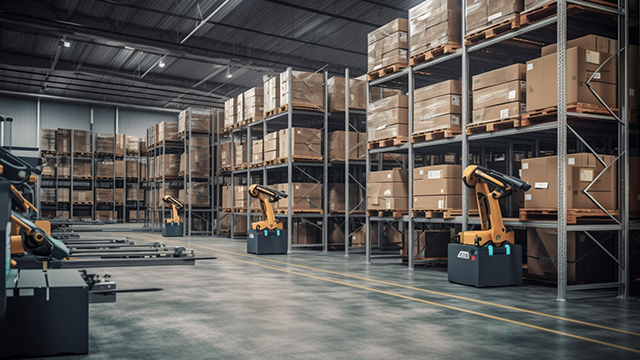
Explore the benefits of using Industry 4.0 principles to modernise your clients’ warehouse operations.
Industry 4.0 is changing the way businesses and enterprises operate. New technologies enable automation and data collection and analysis, making processes faster, more efficient, and cost-effective. And future-forward companies are extending those advances from the shop floor and production line to create not only Industry 4.0 operations but also Warehouse 4.0.
What is Warehouse 4.0?
Warehouse 4.0 (W4.0) is essentially the combination of Internet of Things (IoT), wearables, big data, data science, augmented reality (AR), artificial intelligence (AI), and low-cost sensors that work together to build robust and “smart” warehouse and distribution centres. Warehouses’ closed environments lend themselves to automation, streamlining receiving, picking, packing, and shipping processes and enhancing employees’ performance.
Warehouse 4.0 is more than implementing a warehouse management system (WMS). Instead, it’s creating a smart warehouse that reduces waste, saves time, increases accuracy, and consistently complies with company policies and procedures.
Modernising operations also has benefits beyond the four walls of the warehouse. Businesses can enhance relationships with customers with fast, flawless service. Additionally, data from a smart warehouse can keep supply chain partners informed of inventory and shipments, informing their forecasting and planning and allowing them to take action immediately if delays, stockouts, or other unexpected events occur.
Components of a Warehouse 4.0 Operation
To help your clients evolve into Warehouse 4.0 operations, consider how these technologies can work together to automate and optimise processes.
- Internet of Things: In a warehouse, IoT can be utilised with a company’s tracking and monitoring processes for real-time locationing, optimising storage and inventory management, and improving productivity and safety. IoT sensors can also automate temperature and humidity-controlled storage.
- Big Data and Analytics: Demand forecasting and historical order analysis are two benefits of big data. The real-time information organises and creates a more efficient shelf layout and warehouse space. Your clients will always know exactly what products are available and where they are, and will help adapt to dynamic market needs.
- Augmented Reality (AR): When AR is used in the warehouse, employees can do their jobs more efficiently. For example, an AR system will tell them which route is best to fulfill an order, optimise movement on the warehouse floor, and enhance picking with 3D visualisation.
- Wearables: Warehouse wearables decrease touchpoints and seamlessly interface with other warehouse applications. They simplify tasks and keep employees focused on important components of their jobs. For example, a voice-picking headset enables an employee to work uninterrupted rather than stopping at a computer workstation to print orders or carry a mobile computer that doesn’t permit hands-free work.
- Computer Vision: Computer vision is a type of AI that uses smart cameras to gather data from images and videos and recommend actions based on that information. It can increase accuracy and compare orders and shipments to high-quality standards. Smart pallet systems can even confirm that boxes are on the right pallets to minimise errors and reshipping costs.
- Robots and Cobots: Robotics enable your clients to automate all or parts of warehouse processes, such as assembly, packaging, bin picking, and inspections. Robotics provide workers extra “hands” in daily warehouse processes and save employees steps by transporting items or recycling.
Benefits of the 4.0 Warehouse
Even a small step towards becoming a smart warehouse will significantly benefit your clients’ operations. Furthermore, a systematic, iterative approach that automates single processes and integrates them into the warehouse management system or enterprise resource planning system (ERP) can allow the warehouse team to see the benefits of a Warehouse 4.0 operation, increase buy-in, and stay within a business’s IT budget.
At each step, reduced costs and higher productivity will result in ROI, order quality, better service, and real-time visibility, making the warehouse more competitive and attractive to potential clients.
Educate your clients on the revolution that is leading to Warehouse 4.0 operations and the technologies that make it possible. Then, lay out a roadmap that will take them there.



